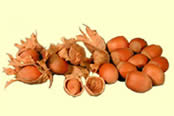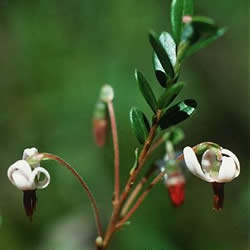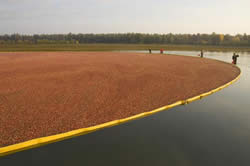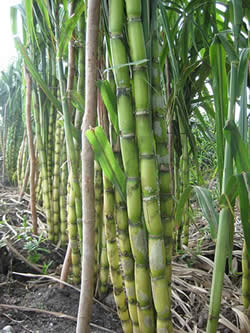- Forest Service Home
- Celebrating Wildflowers
- Home
- About Us
- News & Events
- Wildflower Viewing Areas
- Wildflower Ethics
- Forest Service Regions
- Just For Kids
- Teacher Resources
- Pollinators
- Native Gardening
- Native Plant Materials
- Invasive Plants
- Rare Plants
- Beauty of It All
- Interesting Plants
- Unique Communities
- Ethnobotany
- Special Features
- Wildflower Links
- Contact Us
USDA Forest Service Celebrating Wildflowers
|
|
|
Wild Crop Progenitors What are plant progenitors?
In crop science, the term “progenitor” means the original wild ancestor. Every species of plant that we humans cultivate has one or more wild progenitors, some of which are extinct. For example, the wild progenitor of our modern wheat plants is no longer found in nature. Plant characteristics that are valuable to humans are selected for by breeding those that show these characteristics. During the process of domestication, changes occur in the genes (genotype) of the plant. How the plant looks on the outside (phenotype), and some of its internal processes are altered. Plants are modified through cultivation to suit our needs. When we find a cultivar with characteristics we like such as the color, taste, or texture, we maintain it though cultivation. Occasionally we abandon use of the wild progenitor and in most cases, this ancestor continues to grow in the wild. Grapes
Fun FactIn the book, “The Great Wine Blight” the author George Ordish points out that there was a Spanish decree from 1524 that required all grape vine cuttings from Spain to be grafted onto native rootstocks in Mexico to bring the vines to maturity sooner.
Grapes are one of the oldest cultivated plants, initially cultivated in the Mediterranean area and spreading across Europe and Asia, for which the wild progenitor still exists. Scientists have found grape vine fossils over 60 million years old. Humans have used grapes for food and wine since the earliest times. The wild grape progenitor used in wine making came from only one species Vitis vinifera native to the Mediterranean and Asia. Most of the other 50 or so grape species in the world are from North America. Early French colonists in Florida tried many times to introduce and successfully establish Vitis vinifera vineyards. Each time there was a complete crop failure and these failures were repeated many times in colonial America. These early French viticulturists never discovered the cause of the crop failure. American botanists and naturalists were sending many different species of North American grapes to Europe, especially France. Viticulturists were developing numerous horticultural cultivars. In the mid to late 1850s and the early 1860s, thousands of North American grape vines where being shipped to Europe. A North American aphid, the grape phylloxera, made its way to Europe by 1863. The grape phylloxera attacked Vitis vinifera in a manner never observed on North American grape species. On most North American grape species, this aphid feeds on grape leaves forming galls. In Europe, the grape phylloxera attacked Vitis vinifera by feeding on its small roots. The aphid injects saliva into the roots and then sucks up the sap. The aphid’s saliva is toxic to Vitis vinifera. However, the mystery of why the grapes were dying was not discovered until 1868 when Professor Planchon and his colleagues dug up healthy, dying, and dead Vitis vinifera vines. On the “healthy” vines, they discovered grape phylloxera attached to the roots. It was discovered that by the time the vines were observed dying the aphids had already moved on to their next meal. By this time, nearly 40 percent of French vineyards had been destroyed. Eventually, it was discovered that grafting Vitis vinifera scions on to the phylloxera resistant rootstock of the American species Vitis riparia that the grape phylloxera was defeated. By the late 1870s and 1880s it was generally accepted that grafting Vitis vinifera scions onto an American rootstock, Vitis riparia was the “cure” to keeping Vitis vinifera vines alive, healthy and productive. Thus began the tremendously large and expensive program of reconstituting all the grape vines in France and other European countries by grafting Vitis vinifera cultivars on to Vitis riparia rootstock. Today, populations of Vitis riparia are managed in situ (in place) throughout its range in the United States to maintain its genetic diversity so that when called upon again scientists will have a wild crop progenitor to draw upon. Cotton
Cotton (Gossypium spp.) grows in warm countries around the globe. Asian cotton originated in Africa and India and was cultivated for over 5,000 years. In the 1500s, explorers discovered that cotton plants were also being grown and used in the Americas. The American cotton had longer fibers and was easier to spin into thread. Because of this, it was re-introduced back to Africa where it replaced traditional cultivars. Further domestication modified the cotton plant from its wild progenitor. Did you know?
Filberts (Hazelnuts)European Filberts or hazelnuts (Corylus avellana) are larger and have thinner shells than their North American cousins, beaked hazelnut (C. cornuta) and American hazelnut (C. americana). However, the European hazel is less cold hardy and is susceptible to “filbert blight”. Plant breeders have worked to crossbreed the best qualities of the European to its American cousins. This has produced a superior hazelnut cultivar that is resistant to the filbert blight.
Oregon and Washington produce almost all the filberts in the United States. Would you like to raise a crop straight from a wild progenitor? Find out how to obtain and grow your own delicious hazelnuts. Visit the National Arbor Day Foundation's publication, Hybrid Hazelnuts: An Agroforestry Opportunity (PDF, 1.0 MB). Chiltepin Pepper: “the mother of all peppers"
Fun FactThe Coronado National Forest in Arizona has reserved 2,500 acres in the “Wild Chile Botanical Area”, that provides habitat for the largest population of chiltepin chile peppers (Capsicum annuum var. glabrisculum) north of Mexico.
A small, fiery, round pepper native to Mexico known as chiltepin (Capsicum annuum) is the single wild progenitor of hundreds of sweet or hot pepper varieties found in grocery stores today (jalapeno, poblano, mirasol, cayenne, bell, and others). Habanero and Tabasco are two peppers that did not originate from chiltepin. Chiltepin are the oldest as well as the hottest wild pepper in the Americas. They grow on the rocky surfaces of steep slopes and are difficult to find because they grow in among other shrubs. Did you know?
CranberriesNative to North America, Europe, and parts of Asia, cranberries have not changed much from their wild progenitors. Cranberries grow on low-trailing vines in sandy or peat marshes. Because cranberries, float, their marshes are flooded with water to aid harvesting. Some cranberry beds are over 100 years old and still producing! Native Americans discovered the wild cranberry's versatility as a food, fabric dye, and healing agent. The cranberry (Vaccinium macrocarpon) flower (left) suggests the source of the common name since it resembles a crane’s head. Cranberries grow on vines that seem too small to support such a large fruit. Photos by Robert R. Kowal, University of Wisconsin - Stevens Point, Robert W. Freckmann Herbarium. American and Canadian sailors on long voyages knew they could eat cranberries to protect themselves from scurvy; making them a cranberry counterpart to British “limeys.” Though early sailors did not know about vitamins, what protected them was the high level of vitamin C in the cranberries. The fruit is also high in vitamin A, potassium, and antioxidants. Fun Facts
Cranberries grown commercially in large beds are harvested by flooding the field and gathering the berries with booms and rakes. Photos courtesy Wisconsin State Cranberry Growers Association. Sugar caneLong ago, honey was the only sweetener in the countries beyond Asia, and all visitors to India were taken with the “reed which produced honey without bees”. What was that reed? Sugar cane was the reed. Sugar cane (Saccharum spp.) is a tall grass that looks rather like bamboo. It was known in New Guinea for thousands of years. Sugar cane spread along human migration routes to Asia and India. Here it was crossbred with some wild sugar cane relatives to produce the commercial sugar cane we know today. Explorer Christopher Columbus transported sugar cane from the Canary Islands to what is now the Dominican Republic in 1493. The crop was taken to Central and South America from the 1520s onwards, and later to the British and French West Indies. Fun Facts
Everyone has a sweet tooth! ConservationIt is important that we maintain our wild crop progenitors. They contain genetic variability that may be crucial in the future. Ethics in Plant Collecting in the WildAny plant that has value can be at risk for over-harvest. If you plan to pick things in the wild please follow these basic rules:
See Ethics and Native Plants for more information about plant collection. |
|
| NOTE: PDF format links require the Adobe Acrobat Reader to view. | |
| top | Disclaimers | FOIA | Privacy Policy | Quality of Information | Photo Credits & Use |
Location: http://www.fs.fed.us/wildflowers/ethnobotany/progenitors.shtml
Last modified: Wednesday, 13-Oct-2010 14:31:13 EDT






















